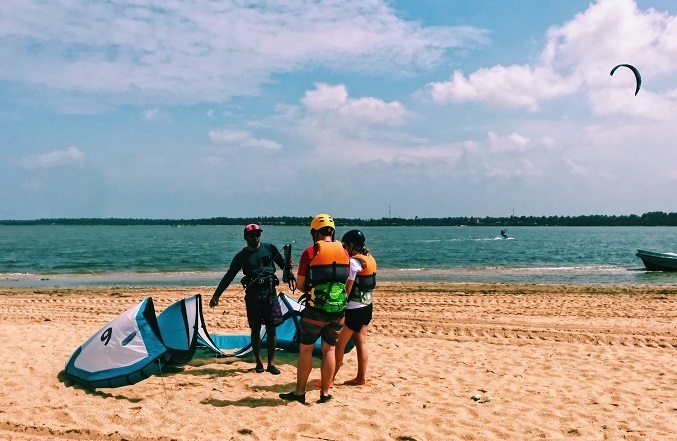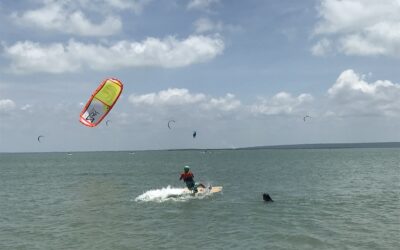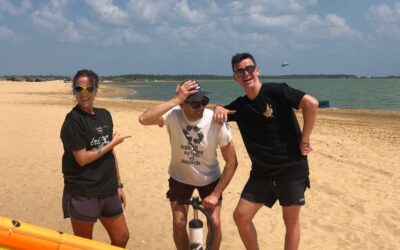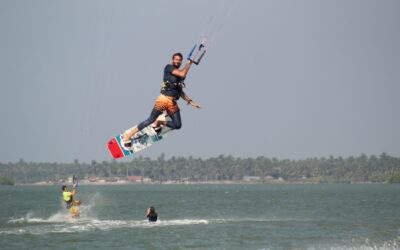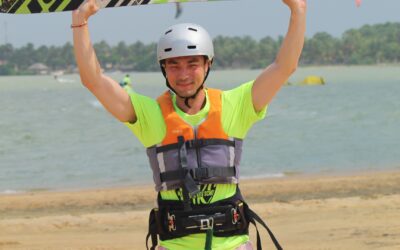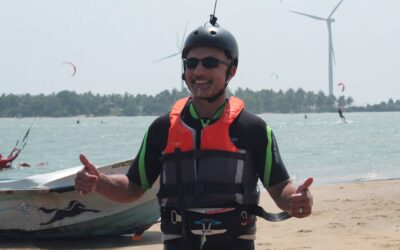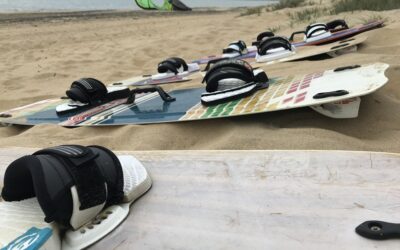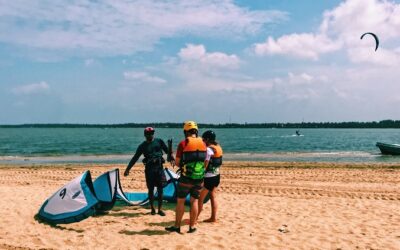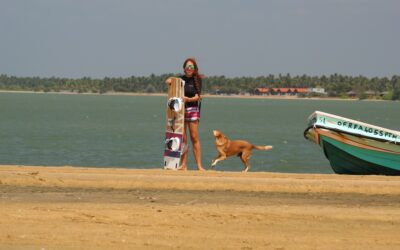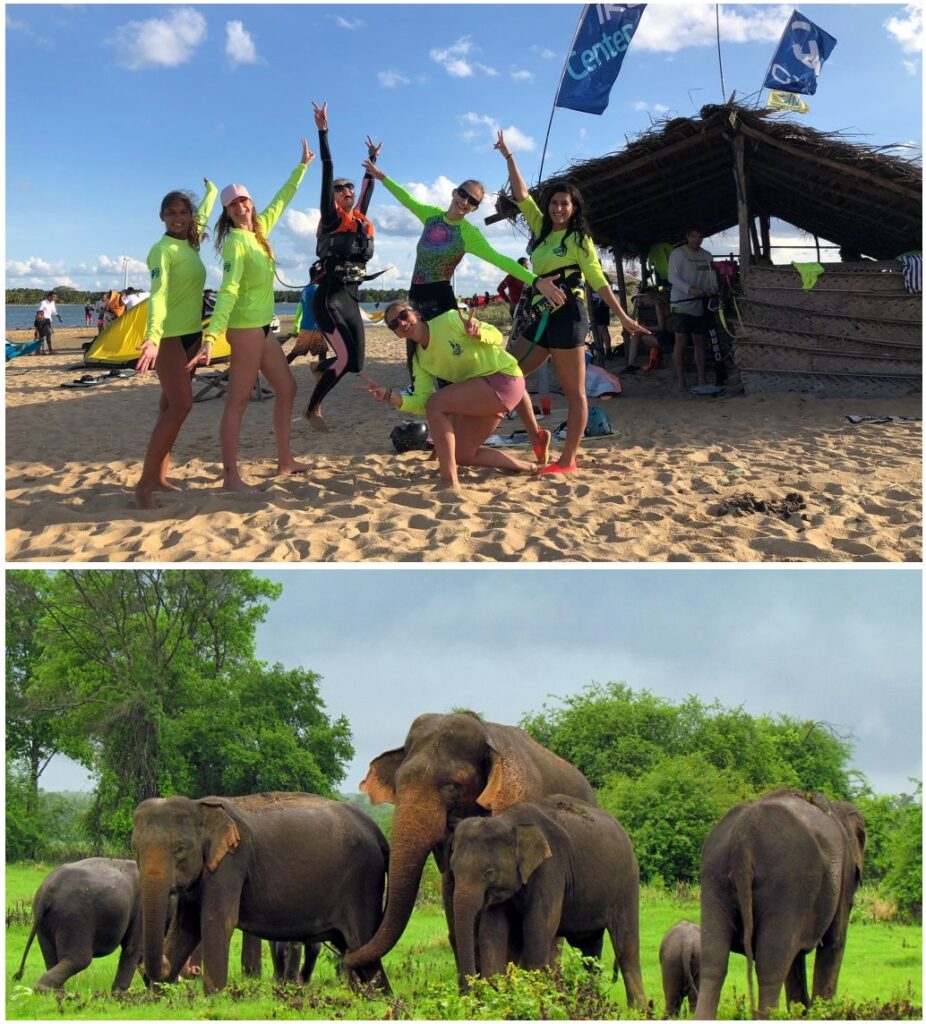The ultimate guide to Kitesurf for beginners
Are you thinking of starting a new challenge in your life by learning to kitesurf? Here we leave you the perfect guide for beginners: from choosing the right teacher to buying the equipment. If you are just beginning to kite, here you have some good tips for beginners.
Kitesurfing or kiteboarding became the number 1 watersport a few years ago. And if you still believe that an extreme sport is not within your reach, it is because you have not read this post yet. Here you will discover in a very simple way how to get started in this wonderful world and some more technical things. Yes, kitesurfing calls you incessantly to practice sports in nature, to connect with the sea and to inject a good dose of adrenaline into your veins.
From outside, kitesurfing seems like one of the most fun sports that can be done on the water, but how do you get started? Where can you learn and how long does it take?
Without further ado, let’s go over the most crucial points when we talk about beginning to kite;
What is kitesurfing?
Kitesurfing is a water sport in which the force of the wind is your engine and where you use a kite and a board to propel yourself through the water. Despite its name, we are not talking about surfing waves. Kitesurfing can be done in calm lagoons, rough seas, or in big waves. All you need is wind and water.
Why learn to kitesurf?
Well, this is the first question that will come to any beginner´s mind. Here we give you some good reasons why you should begin learning kiteboarding:
* Easy learning. Yes, believe us, kitesurfing is not so hard to learn, even if you are thinking right now that this is totally false. You will have to spend hours learning like many things in life, but before you realize you will be upon your board and enjoying the waves
* Relatively safe. Yes, kitesurfing is not as dangerous as parachute jumping. Obviously, there are risks as in all extreme sports and here, being conditioned by the force of the wind and natural forces, they can be extra dangerous but if things are done correctly kite does not have to be dangerous. All the equipment and safety systems in the last 10 years have evolved by leaps and bounds, making this sport quite safe, if you know what you are doing.
* Dynamic. Kitesurfing is a very dynamic activity compared to other sports. We are not here to discredit other types of sports, because we love them all, but we think this point has been fundamental for its growth. You will always be on the go and you will never stop learning and trying new tricks or switching to other disciplines. The dynamism and the possibilities are so high that you will never get bored or think that you are stuck.
* Addictive. When you try the kite it makes you dependent on the wind, you become an expert meteorologist in order to get your dose. And it is that the sensation of sliding, together with the connection with the natural environment, flying high and the freedom that it gives you will make you invade a feeling of fullness and well-being like few times. It is something different and unique at your fingertips. In kitesurfing, there is a lot of fun and evolution. When you master the basics of riding upwind and upwind, you can start to go faster, jump, do freestyle tricks, surf waves or score long ‘downwinders’ all over the coast.
Another question that comes in mind to anyone who begins kitesurfing is; will I be able to learn to kitesurf?
Well, the good news is that anyone can learn to kitesurf. From 10-year-olds to 85-year-old men and women! There is a wide age range of people who enjoy this exciting sport. So you too can learn to kitesurf. Contrary to common belief, you don’t have to be extraordinarily strong or in incredible physical shape to begin with kitesurfing. Naturally, you will feel super fit and strong if you kitesurf regularly, but this is not a requirement for learning. The bad news is that you can’t go out and buy a kite, hit the beach, and get started on your own.
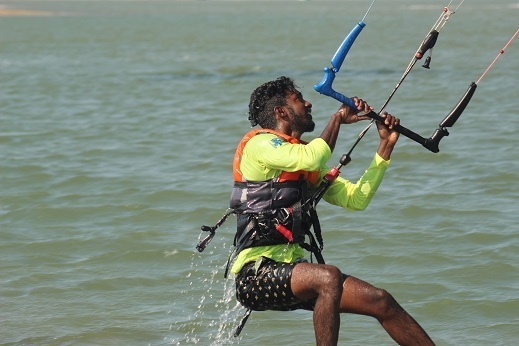
What skills do you need to start this sport?
Most newbies are completely new to board sports, water sports, and kite flying, so lessons always start from scratch. If you are one of these beginners you are probably wondering in what form do you need to be to practice it, right?
Let us tell you that you don’t need to be in shape to kitesurf. And the kit is light, so you don’t need a lot of muscle. However, a minimum level of fitness will help you to progress faster, give you more endurance in the water, and help you avoid injury.
Do you need to receive a class before beginning to kitesurf?
Yes. Any kitesurfer who respects the sport will agree that beginner lessons are essential. In addition to getting up on the board and riding it as quickly as possible, a good instructor will provide you with essential safety knowledge. Without this minimal knowledge, you can be dangerous for yourself and everyone else.
Begin to kitesurf in a responsible way. Unlike many other sports that you can learn yourself through trial and error, kitesurfing needs the supervision of a qualified kitesurfing instructor. This is for your interest since it requires a technique and levels of learning but also for safety reasons. Also, do you want to risk breaking that sexy new kite you just bought because you don’t know how to put it together correctly or launch and land it safely? Investing in a few lessons with a kitesurfing instructor will be money well spent as you will not only become a more responsible kitesurfer, but you will also learn much faster and have a lot of fun”
Where can you receive kite lessons for beginners?
You can find kitesurfing schools and instructors all over the world.
How can you choose the right kitesurfing teacher or school?
A highly experienced instructor is well qualified to train you safely and successfully. They must also have a great passion for people. Without this, they are unlikely to give. The care, attention and trust that novice kiters need. If you’re not sure, ask your friends or other kiters for recommendations.
If you are learning abroad, make sure you can easily communicate with your teacher. And don’t be afraid to ask about the equipment you are going to use. Learning with new equipment in excellent condition is ideal. Beginners should always be given suitable vests and helmets.
What equipment do you need to receive the beginner lessons?
Any decent kitesurfing instructor or school should provide the equipment. They will have a range of different kites, boards and safety gear to suit your needs and a full range for different wind conditions.
In some cases, you may need to use your wetsuit. That is a matter of consulting with the school. Sun protection is also essential, especially if you are going to learn abroad. You should bear in mind that in your kit you should include things like waterproof sunscreen, protective shirts (with a thin top to protect your arms), a cap and polarized sunglasses.
What will I learn as a beginner?
A standard course for beginners is divided into three main aspects:
* Fly a kite on the ground: take off, land and control the kite.
* Fly a kite in the water: body drag, control and relaunch.
* Get up and ride on the board
Within these aspects, you will also learn about the following terms:
* Evaluation of a specific area to know if it is in * safe conditions for kitesurfing.
* Understand the direction, force and gusts of the wind.
* Understand tides, currents and dangers.
* Choose the right equipment for each condition.
* Assembly, set-up and packaging of the equipment.
* Safety procedures and what to do in an emergency.
* Boots from the table (and how to get on it).
* Continuous driving and speed control.
* How to stay on the board against the wind (riding upwind)
How many lessons do beginners need to take before they can get up and actually kitesurf?
“Most people need 10-12 hours or a three-lesson course to get up and ride. Some need more; some need less. For example, if an apprentice has previous experience in other sports of this style (such as wakeboarding or windsurfing)
5 Advanced Kitesurfing Tricks You Can Try Today!
5 Advanced Kitesurfing Tricks You Can Try Today! So you have mastered the basic and mid-level kitesurfing and now looking to step up your skills? The surprising thing about kitesurfing is that there is always something to learn, no matter how skilled you are!...
How difficult is it to learn kitesurfing ? Is it hard to learn?
One of the most crucial questions that somebody who is up to learn kitesurfing is; Is kitesurfing easy to learn? How hard is it to learn to kitesurf? Can you learn kitesurfing on your own? Well, let us tell you that kitesurfing is not a sport which is really hard to...
How much does it cost to learn kitesurfing? Kitesurfing lessons cost
Are you wondering how much does it cost to start kitesurfing? In this article you will find out how much does it cost to start kitesurfing, own your own equipment and to continue practising on the kite beach without an instructor. When countless colorful kites fly...
Learn how to jump in Kitesurfing
Did you know that performing a kite jump is the best sensation that this sport can offer you? Jumping is probably the kite trick that offers the most feeling of freedom. For that reason, we have developed this guide on how to learn to jump in kitesurfing. Do you want...
How long it takes to learn kitesurf?
How long does it take to learn to kitesurf? This is a question that many people ask themselves when learning to kitesurf. According to my experience as an iko instructor, one of many things I learned is that you should never assume how fast or slow a student can learn...
Learn how to bodydrag
HOW TO BODY DRAG KITESURFING The Body Drag is one of the essential techniques of kitesurf and it is not only important to know it and practice it in the beginning, this technique is also used for more advanced riders to try new tricks without taking many risks. For...
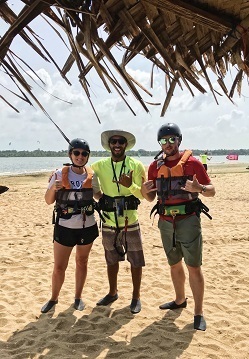
How do you know when it’s time to finish the lessons?
First of all, it is essential that you have the go-ahead of a qualified instructor. They can give you a card indicating that you have reached the appropriate level (level 3 for IKO) to be independent and be able to rent the equipment.”
The final decision is between the student and the instructor, and you should only kitesurf independently when you feel 100% ready. If not, book more classes, training, supervision or take a refresher course.
What are the main challenges you will face as a beginner?
Building trust and trusting your team is the first hurdle for many. Some people take a long time to gather enough confidence to get started.
Beginners usually get used to flying a kite and body drag quite quickly, but controlling the kite in all conditions, getting on the board and fighting the wind is another matter. This usually takes more time, patience, and practice.
What equipment should you buy as a beginner?
There is no need to buy anything right away as any good instructor will provide you with the equipment. You will have a better idea of what to buy when you’ve completed the course. For example, the location where you plan to kite will make a difference in the size of the kite you need.
There are times when beginners learn with a harness on a seat, a larger board, and a life jacket. Later on, you’ll probably want to switch to a waist harness, a smaller board, and a lower-profile vest.
On the other hand, many kites are suitable for all levels. The most common designs have an inflatable top edge and a zip tie to hold the lines. At the beginner level, you don’t have to worry too much about specialized designs, as modern, ‘everyday’ kites are often shaped like a ‘bow’ or ‘delta’ (both are good for beginners).
Other types of kites include C kites (high power and lift), hybrids (a cross between a C kite and a bow kite) and aluminium kites (used for hydrofoil kitesurfing).
When you’re ready to buy, ask your instructor to help you choose the kite and kit that is best for you. The kitesurf kit is light and easy to transport.
1) Civil and health liability insurance that covers the treatment of possible injuries. Kitesurfing accidents are very frequent, especially kite beginners, that is why insurance companies have taken on the task of designing products that include protection for those who practice this exciting sport. If you are a beginner, it is worthy of expending around 50 euro and kitesurfing fully covered
2) Anemometer. As a beginner, it is a must you know the wind conditions and if the wind is in the range of your kite. An anemometer will help you with that. It cost around 40 euro.
3) Kite. Find out which winds are the most frequent in your area and what is the intensity of these winds. Depending on your weight, better to choose a kite that allows you to kite the most significant number of days. (It will cost you about € 1000 + – € 300 depending on brands and sizes 10-12 meters new material)
4) Board. If the board is medium or large, you will progress faster because you will glide over the water more efficiently. As a beginner, choose a board between 138 and 150 cm (A beginner board will cost you around 300- 500 euro depending on brands)
5) Harness. To begin with, those that have hooks to put the legs are more comfortable because it prevents the harness from climbing upwards. (About € 120 + – depending on brands).
6) Vest. There are some specific vests for kitesurf that can fit well to the body, give you buoyancy and do not bother you. A safety vest will safe you from many problems if your kite falls and you are quite far from shore.
7) Helmet. Using a helmet is very important in areas of narrow beaches, crossed by rocks or in areas of shallow waters and obstacles.
8) Booties. They are recommended at the beginning when the area is stony or sharpie because you will kick a lot. Avoid stacking things on your feet (pebbles, algae, spider fish). (About € 25).
9) Neoprene. Depending on where you kite, in winter you will surely need a long neoprene. A short neoprene is also not bad for spring-autumn in the Mediterranean or for summer in the Atlantic. (Price according to brands, around 100 euros)
How much does kitesurfing equipment cost?
For many people who are new to kitesurfing and want to learn, a commonly asked question is how much kitesurfing gear costs. However, the answer to this question is not a straightforward one - The price of kitesurfing equipment varies between items and even between...
Kite gear maintenance: best practices for a long life of your kitesurfing equipment
Have you just started in the sport and still don't know very well how to keep your kitesurfing equipment in the best conditions? Your Kitesurfing equipment is very important, and if you love it and you want it to last for a long time, you must maintain it in the best...
The ultimate guide to beginner kitesurfing boards
Have you finished your kite course and you don't know which initiation board is the most suitable for beginners? In this post, we will help you to choose the best beginners kitesurfing boards and the ones which you can progress faster. There is always a hard time in...
There are many beginner mistakes in kitesurfing. From our kitesurf school we have seen a lot, believe us. That is why we always work to minimize the following errors that usually happen beginners. Many times mistakes occur due to lack of practice, but sometimes it is due to lack of concentration or even overconfidence. As a beginner, we recommend that you keep the following points in mind to avoid accidents:
Mistake nº 1: not talking to local riders.
Do not be shy! Come in good vibes, introduce yourself to the local riders and ask them the general rules of the area. They can share with you about the forbidden zones or any other danger you may face. The gesture of approaching them to ask them will be a good start so that they stop seeing you as an intruder that hinders them. We have all been beginners in a new spot at some time in life!
Mistake nº 2: assembling your kite without checking the bridles.
The bridles of your kite shouldn’t be tangled. Check them twice before taking off.
Mistake nº 3: holding the bar with both hands before taking off
Holding it before taking off can cause you to lose your balance or fall into the sand. Remember to release the bar until your partner has the kite ready for taking off. Detangle your lines, and you are good to go.
Mistake nº 4: pulling the bar close to your body when taking off
As in the previous point, this will make you lose control and most likely give you a holy güamazo. It is unnecessary. If you pull the bar close to your body when taking off, two things can happen: a) the kite enters the power zone, and you fly off or b) the kite falls backwards. What you should do is lean your body forward, your shoulders facing the bar with your arms extended.
Mistake nº 5: yelling or making strange gestures before taking off
Doing this will only generate confusion in the partner who helps you to take off your kite. He may misunderstand you and drop the kite when you are not ready. Just lift your thumb when you’re willing to take off (This is the international sign and everyone understands it)
Mistake nº 6: giving the kite a hard push when taking off
When you help someone else take off their kite, you shouldn’t give them a hard push. This way, you only get him to plummet to the ground. To get it right, all you have to do is hold the kite and, on the signal from your partner, gently drop it on you. So it will fly alone.
Mistake nº 7: catching the kite by taking the trailing edge
On landing, catching your partner’s kite taking the trailing edge – that is, the rear edge – is not recommended. Take it from the leading edge (the front end), it’s much safer for everyone.
Mistake nº 8: taking power out of the kite by getting down on your board
When you already have your kite floating above you, and you kneel to reach your board, you may take power away. If this happens, your kite will fall from the sky. To do it correctly, keep the pressure on the bar or keep your kite lower on the edge of the wind window.
Mistake nº 9: going too close to shore
When you have the onshore wind (the wind blowing from the sea towards the coast), leaving the water without maintaining distance from the shore results in disaster. Your keels will get stuck in the sand, and you will fly off. Walk into the water to a safe distance and avoid doing the mega bear in front of other riders.
Mistake nº 10: pulling the bar too hard when landing
As soon as your partner holds the kite, release the bar. If you hold on to it, it won’t be very pleasant for both you and the other person.
If you realize, they are not very difficult things to modify. It’s really about having the knowledge and applying it. But if we can give you an infallible recommendation, it is: take classes with experts. There is no YouTube tutorial or blog article that provides good training. There is too much at risk if you skip learning with professionals and throw yourself into the ring; there is no need for that.
Learning with the pros will not only make you know your equipment, tips and safety measures well, but you will also get to see the community where you practice more efficiently. Also, having a good technique, you can avoid most of the typical injuries of this extreme sport. These range from a simple scrape to strains, sprains and fractures of the foot, ankle and knee. In the worst-case also a vertebral fracture. Accidents happen, but having the right knowledge will significantly reduce your chances of suffering them.
The best kitesurfing spots in the world
"From Asia to America, from East to West. Explore some of the world's finest kitesurfing spots. And, no sharks!" Maybe you’ve been kitesurfing for a while, and want to try exciting new waters? Holidays to famous kitesurfing destinations around the world is all part of...
The ultimate guide with the top kitesurfing spots in Asia
If there’s one sport that can enthral your senses and make you feel more attached to the beautiful nature, it’s kitesurfing. The kitesurfing community is moving towards a new goldmine for surfing. Asia, though underrated, is home to some of the best kitesurfing spots....
The ultimate guide with the top flatwater kitesurfing destinations
Best places in the world to kite in flat water Be it surfing over the clearest of waters or performing gravity-defying stunts near the dock, kitesurfing, and its adrenaline boost is unrivalled. A passionate alliance of wind and water, kitesurfing provides...

